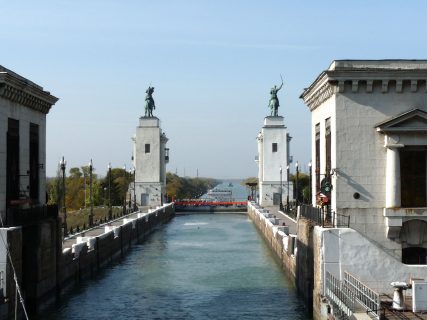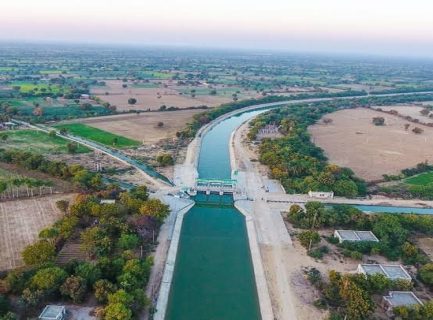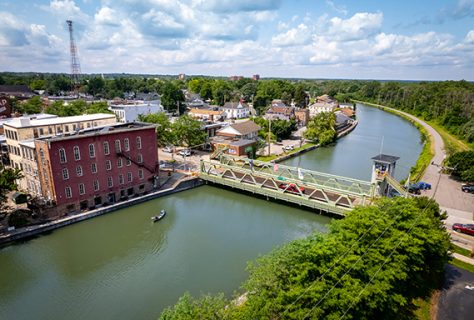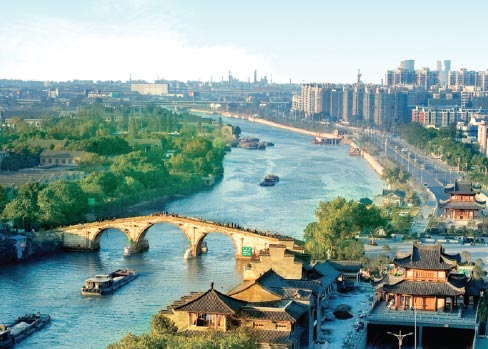These are the top five completed and operational longest canals in the world.
-
The Grand Canal in China | 1,776 km
The Grand Canal is currently the longest in the world. At its peak during the Ming dynasty (1368-1644 AD), the canal was approximately 2,500 kilometres. Beijing was its northernmost extension, Hangzhou its southernmost point, and Luoyang its easternmost point.
The canal connected the political centre of the empire in the north (especially from the Song dynasty; 960 AD) with the economic and agricultural centres of the central and southern regions of the kingdom. This was mainly achieved by linking two of the country’s most important river basins, the Yellow River (Huang He) and the Yangtze River (Chang Jiang).
The grand canal ascends a gradual slope to an elevation of more than 40 meters north of the Yangtze. A system of locks (the Chinese are attributed to the first lock ever built in 983), feeder lakes, and lateral canals were constructed to ensure safe circulation.
Today, the canal is about 1,776 kilometres long and it is still heavily used in the Yangtze delta. 100,000 river vessels or its thereabouts transit on the canal each year, carrying approximately 260 million tons, mostly construction material. Therefore, the canal offers an alternative to move ponderous goods that otherwise couldn’t be handled effectively by China’s transport system.
2. Karakum Canal in Turkmenistan | 1,375 km

Also known as the Great Turkmen Canal, the Karakum Canal is the second-longest canal in the world. The infrastructure is located in Turkmenistan, a country in Central Asia bordered by the Caspian Sea and largely covered by the Karakum Desert.
The construction of the approximately 1,375 kilometres canal began back in 1954 and was completed 34 years later in 1988. The main reason for its construction was to divert water from the Amu Darya River to irrigate the arid Karakum Desert.
With a capacity for 13 cubic kilometres of water annually, the Karakum Canal allowed for the cultivation of cotton, fodder crops, vegetables, and melon crops. Additionally, the canal has led to the creation of fishery farms, water desert pastures and the development of distant-range grazing of cattle. Moreover, the canal is used in shipping and its waters in industry and power engineering.
3. Manych Ship Canal in Russia | 700 km

The world’s third longest canal is the 700-kilometre Manych Ship Canal that links the Black Sea, the Sea of Azov and the Caspian Sea. The canal, the construction of which began in the 1930s includes the existing Manych Waterway through Lake Manych-Gudilo and the Veselovskoe and Proletarskoe reservoirs.
There are plans to turn the Manych Ship Canal into a multipurpose water-resources system and a limb of international transport. This plan includes the deepening of the canal to 6.5 meters and widening it to 80 meters so as to increase its capacity from 15 million to more than 75 million tons of cargo per year.
The canal will also be extended to the Caspian Sea via the sparsely populated steppes of Kalmykia and be renamed the Eurasia Canal. If completed the canal would link several landlocked countries in Asia with the open seas through the Bosphorus.
4. The Indira Gandhi Canal | 650 km

Originally known as the Rajasthan Canal, the Indira Gandhi Canal is the fourth longest canal in the world.
The 650 kilometres facility starts at the Harike Barrage near Harike, only a few kilometres downriver from the confluence of the Satluj and Beas rivers in Punjab state, and ends at the irrigation scheme in the Thar Desert, northwest of Rajasthan state.
The first 167 kilometres of the canal comprise the Rajasthan feeder canal in Punjab and Haryana state and a further 37 kilometres in Rajasthan. This is followed by the 445-kilometre Rajasthan main canal that is entirely within Rajasthan.
The construction of the Indira Gandhi Canal began back in 1958 and it was first used in 2005. The last portion of the canal was delivered in 2010. Its name was changed from Rajasthan Canal to Indira Gandhi Canal on 2 November 1984 following the assassination of Prime Minister Indira Gandhi.
5. Erie Canal in New York | 584 km

The Erie Canal is the fifth longest canal in the world. The historic canal in upstate New York that runs east–west between the Hudson River and Lake Erie was completed back in 1825 after approximately 8 years of construction.
Its construction involved impressive feats of engineering, including the creation of locks and aqueducts to navigate elevation changes and cross rivers. Following its completion, the Erie Canal became the first navigable waterway connecting the Atlantic Ocean to the Great Lakes, and the second-longest canal in the world after the Grand Canal in China.
Also Read
Canal Construction: The World’s 5 Most Massive Canal Projects
Argentina and Saudi Arabia partner to build the joint water canal
$8bn green hydrogen plant to be developed in Egypt’s Suez Canal
